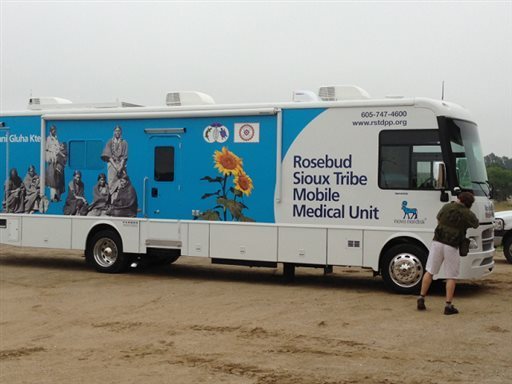Wellness Center and Mobile Medical Unit Boost Education and Screening Efforts through Partnership with Novo Nordisk
ROSEBUD, SD, August 23, 2013 – Addressing one of the biggest health problems facing Native American communities everywhere, the Rosebud Sioux Tribe today unveiled a new, state-of-the-art wellness center and a first-of-its kind mobile diabetes medical unit. These resources will allow the Rosebud Sioux Tribe Diabetes Prevention Program (RSTDPP) to improve screening and intervention in children, as well as promote healthy lifestyles for people of all ages on the reservation. The center and mobile unit were made possible through funding from global healthcare company Novo Nordisk as part of its Native American Health Initiative.
“Diabetes is a serious problem for my tribe, but we know we can turn it around,” said RSTDPP Director Connie Brushbreaker. “Education and screening can help raise awareness about diabetes. The wellness center and mobile unit are smart ways to help us reach more people on our reservation and provide valuable disease education.”
Overall, American Indian and Alaska Native adults are more than twice as likely to have diagnosed diabetes compared with non-Hispanic whites.[1] In some American Indian/Alaska Native communities, diabetes prevalence among adults is as high as 60%.[2]
The new wellness center will house exercise facilities, diabetes education and nutrition training space, and exam rooms. The facility will also provide secure storage for the mobile medical unit, which can travel to the remote corners of the reservation to promote diabetes education, screening and prevention to residents that have limited access to care.
The enhanced diabetes prevention and screening efforts were recommended as part of a thorough, four-month assessment of the diabetes care and educational programs currently available to residents of Rosebud by the internationally-recognized Park Nicollet International Diabetes Center, a nonprofit diabetes care, education, and clinical research facility based in Minneapolis, Minnesota.
“This program has several important components to addressing diabetes in Indian country,” said Donald K. Warne, MD, MPH, professor at North Dakota State University and advisor to the project. “One of the most important issues is making an early diagnosis before complications start to occur. Too often, once a diagnosis is made there are barriers to accessing medical care, so bringing professional medical services to people through a mobile unit is both innovative and essential to improving quality of care.”
The initial investment of $3 million from Novo Nordisk also enables the formation of a diabetes education program for healthcare professionals and patients, the implementation of a community awareness initiative for diabetes prevention, and the creation of scholarships through the support of the American Association of Diabetes Educators that will allow tribe members to be trained as certified diabetes educators.
Curt Oltmans, corporate vice president and general counsel at Novo Nordisk, grew up near the Rosebud Reservation and witnessed the disparities in care facing the Native American population first-hand. He is leading Novo Nordisk’s Native American Health Initiative.
“For more than three years Novo Nordisk has engaged with the Rosebud Sioux Tribe to design this initiative,” Oltmans said. “As a leader in diabetes, we believe that diabetes education and prevention are essential. Our Diabetes Educators have trained the community’s health representatives and members of the Diabetes Prevention Program. It has been a privilege for our employees to learn about the tribe’s traditions and culture. We are committed to the program and we want it to become a model for others.”
For the latest on the RSTDPP, visit www.rstdpp.org.
About Rosebud Sioux Tribe
The Rosebud Sioux Tribe, a branch of the Lakota people, is located on the Rosebud Indian Reservation in south central South Dakota. The federally recognized Indian tribe has more than 31,000 enrolled members and over 11,300 individuals currently residing on the reservation and its lands. The reservation has a total area of 1,442 square miles, while the total land area and trust lands of the reservation cover 5,961 square miles. The reservation includes all of Todd County, S.D. and extensive lands in four adjacent counties. The tribal headquarters is in Rosebud, S.D. For more information, visit www.rosebudsiouxtribe-nsn.gov.
[1] Source: American Diabetes Association, Native American Complications (http://www.diabetes.org/living-with-diabetes/complications/native-americans.html)
[2] Source: Special Diabetes Program for Indians Overview, May 2012 (http://www.ihs.gov/MedicalPrograms/Diabetes/HomeDocs/Resources/FactSheets/2012/Fact_Sheet_SDPI_508c.pdf)
– See more at: http://www.noodls.com/view/559834ED9E32BB3F409145101A8FDB17D6EB63FD#sthash.6L0U3kz4.dpuf

